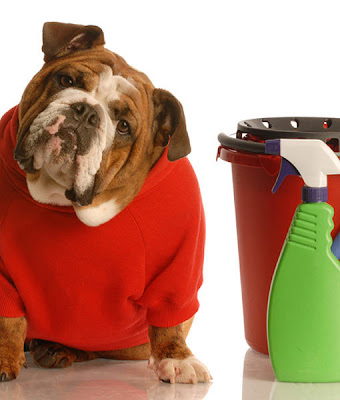In many ways, our pets are like little children—curious, adventurous, and sometimes even mischievous. The difference is, we wouldn't leave our kids home alone all day, the way we do our pets.
10. PAINT
Adults know it's a bad idea to eat paint, but pets don't always get the reasoning behind passing up the chance to tussle with a paint can. It's hard to know exactly what ingredients are used in paint blends, but it's best for your pet and your family to choose no-VOC blends like Yolo Colorhouse. Avoid products that make "antimicrobial" or "mildew fighting" claims—these could contain toxic chemicals linked to thyroid damage. When you're finished painting, store your paint in a detached garage or building—even with the lid closed tightly, fumes still seep out.
For more information on other sources of pet poisoning, including a plant list, visit the ASPCA Poison Control Center website. If you suspect your animal may have ingested a poisonous substance, call the Poison Control Center right away at (888) 426-4435 or contact your vet.
9. LAWN CHEMICALS
The health impacts of pets coming into contact with chemical weed and bug killers could be immediate or they could take years to surface. A 2012 study published in Environmental Health found dogs with malignant lymphoma were 70 more likely to live in a home where professionals applied chemical lawn treatments. Dogs with the serious malignancy were also 170 percent more likely to come from homes in which owners used chemical insecticides to combat pests inside of the home.
8. GLOW JEWELRY
Glow jewelry isn't generally lethal to pets, but cats' tendency to bite into those glow-in-the-dark bracelets and necklaces often leads to panic situations at home. The taste is so bad, cats will drool and race around the house, trying to run away from the terrible taste. If this happens, try to rinse out the cat's mouth, and give it a tasty pet treat to eat to get rid of the bad flavor.
7. RODENTICIDES
Your quest to kill vermin seeking shelter in your home during colder months could cut short your pet's life because certain mouse baits can cause internal bleeding of dogs and cats.
6. CLEANING SUPPLIES
Eating or inhaling cleaning supplies and laundry room products can harm your pet. Furthermore, harsh cleaners are bad for you, too.
5. CERTAIN FLEA AND TICK PRODUCTS
Insecticide poisonings resulted in nearly 30,000 calls to the Poison Control Center in 2010, and a common problem involved using flea and tick products on the wrong species.
4. LILIES
You've probably heard that poinsettias don't belong in homes with cats, and the plants could indeed cause some discomfort, although ASPCA says the toxicity threat is generally exaggerated. Another common plant is much more dangerous. A household with a cat should never have a lily in it, ever. Cats are attracted to the greenery, but munching on a lily-containing bouquet could lead to kidney failure.
3. XYLITOL
Xyli-what? You probably have this substance in your house without even realizing it. It's a sugar alcohol used in gum and toothpaste, and as a sweetener in other products. You can even buy it in powder form for baking. It's great for people because it doesn't cause a spike in blood sugar, and has been shown to reduce cavities. However, xylitol is toxic to dogs, who could experience a dangerous crash in blood pressure if they eat it. The sweetener is also linked to seizures and liver failure in dogs. Keep your gum, toothpaste, and kitchen sweeteners of all sorts in cabinets to avoid an unsweet disaster for your pooch,
2. GRAPES, RAISINS AND OTHER HUMAN FOODS
It's been pretty well publicized that chocolate can be fatal to dogs, particularly dark and baking chocolate. In fact, the ASPCA's poison hotline receives about 21 calls a day on the matter.
Chocolate goodies contain substances called methylxanthines, which in dogs can lead to hyperactivity, excessive thirst and urination, seizures, and even death. Other people food for your pets to avoid includes grapes, raisins, and avocadoes. Instead of feeding your pooch table scraps, make healthy, homemade pet treats.
1. PEOPLE PILLS
For the last four years, the primary reason for calls to animal poison hotlines is that a pet has gotten into its owner's medication. A dropped pill on the floor could seem like playtime for a pet, and some pill coatings even attract pets, leaving them gnawing on medicine bottles and packets. In 2011, 26 percent of calls to the poison hotline involved pets eating over-the-counter and prescription people meds.
Pets eating heart medication and ADHD drugs caused the most calls, but all human drugs could harm your animal, including non-steroidal anti-inflammatories (NSAIDs like aspirin and ibuprofen), antidepressants, acetaminophohen, cancer drugs, decongestants and other drugs.
To prevent this, keep all meds, creams, vitamins, and supplements in a cabinet, and when it's time to take your medicine, go into a room without your pets and close the door—that way if you drop a pill, they can't lap it up. Also note: It's never a good idea to give your pets people medicine because even tiny amounts that are harmless to us could harm or kill them.
All information from PawNation.













0 comments:
Post a Comment